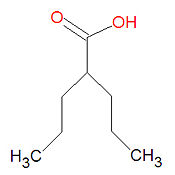Valproic acid
|
| |||||||
| valproic acid | |||||||
| |||||||
| Uses: | anticonvulsant | ||||||
| Properties: | fatty acid derivative | ||||||
| Hazards: | |||||||
| |||||||
Valproic acid is a medication that is "a fatty acid with anticonvulsant properties used in the treatment of epilepsy; the sodium salt is used in treating mood disorders. It also is used for neurogenic pain. It is a colorless to pale yellow liquid that is slightly soluble in water (1.2 mg/mL) but fully soluble in acetone, chloroform, ether and methanol.
The mechanisms of its therapeutic actions are not well understood. It may act by increasing gamma-aminobutyric acid levels in the brain or by altering the properties of voltage dependent sodium channels."[1]
Side effects
Valproic acid causes carnitine deficiency. All patients under valproate therapy should have their carnitine status monitored. Since available tests are not reliable indicators of carnitine status in tissues, prophylactic carnitine therapy can be considered. Intravenous carnitine is markedly superior to oral; oral acetylcarnitine may be advantageously used as well, if the underlying disorder allows it.
Benign hand tremor is not infrequent as a side effect, and can be suppressed, if there are no contraindications to their use, with beta-adrenergic antagonists.
External links
The most up-to-date information about Valproic acid and other drugs can be found at the following sites.
- Valproic acid - FDA approved drug information (drug label) from DailyMed (U.S. National Library of Medicine).
- Valproic acid - Drug information for consumers from MedlinePlus (U.S. National Library of Medicine).
- Valproic acid - Detailed information from DrugBank.
References
- ↑ Anonymous (2025), Valproic acid (English). Medical Subject Headings. U.S. National Library of Medicine.
